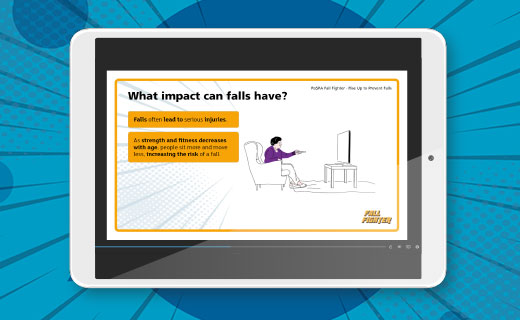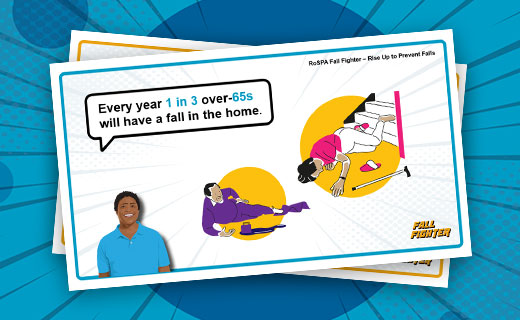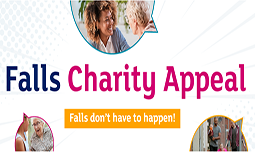Pioneering project reduces falls by nearly 70 per cent among over-60s
Organisation: Trent & Dove
Background: Falls are the biggest cause of accidental injury in the home, resulting in 80 per cent of the hospital admissions for accidental injury to people aged 65 and over. They cost the NHS around £2.3 billion annually and impose an immeasurable burden on society through physical and psychological harm.
National statistics suggest that one in three over-65s, and one in two over-80s, will experience a fall each year. The number of people seriously affected by falls is set to rise as people live longer and populations age.
Based in East Staffordshire, Trent & Dove are a social housing provider with approximately 6,300 affordable properties including four sheltered housing schemes. Around a quarter of Trent & Dove customers are aged over 60.
Inspired by RoSPA’s Fall Fighter campaign, the project aimed to increase awareness of the risks and consequences of falls in older people living in Trent & Dove properties and support them to implement personal prevention measures to reduce their risk of experiencing a fall. Approach: The project was achieved through two main workstreams: educational sessions for customers, staff and community groups; and home visits to help customers identify and address hazards.
Fall Fighter sessions
RoSPA Fall Fighter training materials were adapted and delivered in face-to-face sessions to Trent &
Dove staff, customers, and at community groups. The sessions involved a presentation and informal
discussion about falls, the risks and control measures. A total of 181 attendees were shown how to identify and address fall hazards in their homes.
Fall Prevention Home Visits
All customers aged over-60 were sent a postal introduction to the Fall Prevention Project inviting them to book a fall prevention home visit. Visits were also offered by referral from frontline Trent & Dove staff. Reaching customers without relying on internet access was a key focus during the project.
The free visits were conducted by a dedicated Customer Health & Safety Advisor appointed to deliver the project. Home visits involved health and lifestyle questions and a room-by-room check for fall hazards. Check sheets were used to structure the conversation, introduce risk factors, and ascertain the customers current level of control. A framework based on the customer’s responses helped identify additional controls where necessary, with a focus on using existing services and customer-led actions. Tailoring measures to individual circumstances and involving customers in decision making improved acceptance of the measures.
Concepts of risk management were introduced during visits, enabling customers to identify and address domestic hazards and respond to any future near misses. Support was also provided for issues beyond fall prevention which arose during the visit.
Once completed, the paper check sheets were left with tenants, promoting ownership of the advisories and knowledge sharing with friends/relatives/carers. A photograph of each sheet was taken, and the data securely compiled. Customer profiling data was also collected including age, fall history, use of mobility aids, the type of property occupied, the extent of level-access, and number of bedrooms.
161 customers received home visits between September 2022 and May 2023. These were to houses, flats, bungalows, and sheltered scheme flats. 55 per cent of customers visited had already experienced a fall in the 12 months before their home visit, in excess of the NICE annual national averages. 60 per cent were reliant on a mobility aid.
Results: A total of 242 individual advisories resulted from the health and lifestyle check sheet. The dominant category was the need to exercise (or increase daily activity levels).
A total of 262 environmental advisories resulted from the room by room check sheet. The dominant categories were the need for grabrails, handrails and additional bannisters, and the poor condition of flooring (which encompassed the risks associated with rugs and mats).
To evaluate the impact of visits, a telephone survey took place at least three months after the visit allowing time for advisories to be implemented and the effects to be felt. 98 customers took part.
A huge 69 per cent reduction in falls was measured across all respondents to the survey (calculated by extrapolating the number of falls since the visit and comparing them with the falls experienced in the 12 months before the visit).
Customers suffering most falls before their visit measured the greatest reduction. When surveyed, 85 per cent of customers who were previously fallers had not fallen since their visit. Scheme tenants were amongst those experiencing the greatest reduction in falls, highlighting the importance of individual risk control in reinforcing the effectiveness of pre-existing environmental controls.
In addition to fall reduction, customers reported other clear benefits. 90 per cent of all respondents knew more about fall prevention after their visit; 91 per cent felt safer at home and 73 per cent felt less likely to have a fall at home.
Read the full project report at: www.rospa.com/fall-prevention-for-social-housing-tenants
October 2023
“Until now there has been relatively little data for those in the housing sector about falls in the home, so we hope our work paves the way for other housing associations that are passionate about saving and improving lives.” - Anna Hickman, Head of Health and Safety at Trent & Dove
Join the Fall Fighter movement today and help others live the life they deserve.

My FREE session
Attend this free fall prevention awareness session online - Sign up today.

FREE sessions for your employees
Download the free session materials to deliver the session in-house or download the online e-learning files to run on your own e-learning system.

Get involved with our Falls Charity Appeal
Help us prevent falls and save lives.